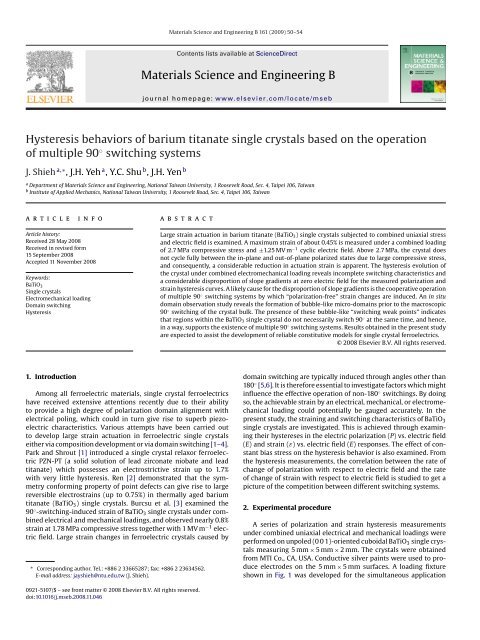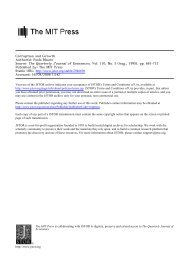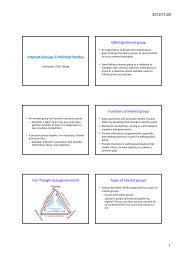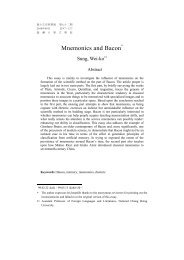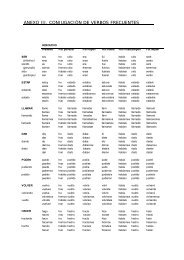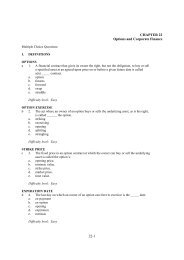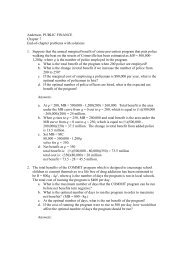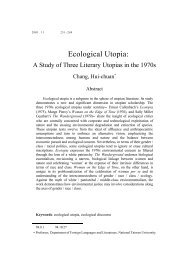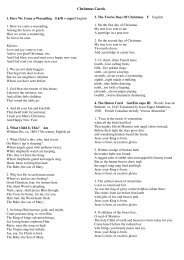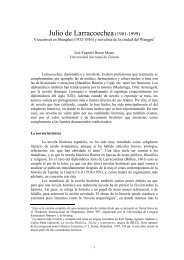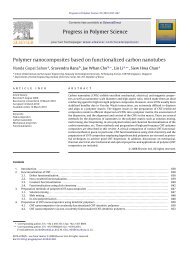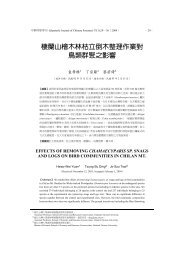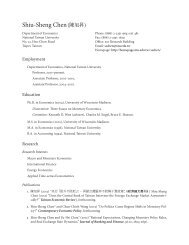Hysteresis behaviors of barium titanate single crystals based
Hysteresis behaviors of barium titanate single crystals based
Hysteresis behaviors of barium titanate single crystals based
You also want an ePaper? Increase the reach of your titles
YUMPU automatically turns print PDFs into web optimized ePapers that Google loves.
Materials Science and Engineering B 161 (2009) 50–54<br />
Contents lists available at ScienceDirect<br />
Materials Science and Engineering B<br />
journal homepage: www.elsevier.com/locate/mseb<br />
<strong>Hysteresis</strong> <strong>behaviors</strong> <strong>of</strong> <strong>barium</strong> <strong>titanate</strong> <strong>single</strong> <strong>crystals</strong> <strong>based</strong> on the operation<br />
<strong>of</strong> multiple 90 ◦ switching systems<br />
J. Shieh a,∗ , J.H. Yeh a , Y.C. Shu b , J.H. Yen b<br />
a Department <strong>of</strong> Materials Science and Engineering, National Taiwan University, 1 Roosevelt Road, Sec. 4, Taipei 106, Taiwan<br />
b Institute <strong>of</strong> Applied Mechanics, National Taiwan University, 1 Roosevelt Road, Sec. 4, Taipei 106, Taiwan<br />
article info<br />
Article history:<br />
Received 28 May 2008<br />
Received in revised form<br />
15 September 2008<br />
Accepted 11 November 2008<br />
Keywords:<br />
BaTiO 3<br />
Single <strong>crystals</strong><br />
Electromechanical loading<br />
Domain switching<br />
<strong>Hysteresis</strong><br />
1. Introduction<br />
abstract<br />
Among all ferroelectric materials, <strong>single</strong> crystal ferroelectrics<br />
have received extensive attentions recently due to their ability<br />
to provide a high degree <strong>of</strong> polarization domain alignment with<br />
electrical poling, which could in turn give rise to superb piezoelectric<br />
characteristics. Various attempts have been carried out<br />
to develop large strain actuation in ferroelectric <strong>single</strong> <strong>crystals</strong><br />
either via composition development or via domain switching [1–4].<br />
Park and Shrout [1] introduced a <strong>single</strong> crystal relaxor ferroelectric<br />
PZN-PT (a solid solution <strong>of</strong> lead zirconate niobate and lead<br />
<strong>titanate</strong>) which possesses an electrostrictive strain up to 1.7%<br />
with very little hysteresis. Ren [2] demonstrated that the symmetry<br />
conforming property <strong>of</strong> point defects can give rise to large<br />
reversible electrostrains (up to 0.75%) in thermally aged <strong>barium</strong><br />
<strong>titanate</strong> (BaTiO 3) <strong>single</strong> <strong>crystals</strong>. Burcsu et al. [3] examined the<br />
90 ◦ -switching-induced strain <strong>of</strong> BaTiO 3 <strong>single</strong> <strong>crystals</strong> under combined<br />
electrical and mechanical loadings, and observed nearly 0.8%<br />
strain at 1.78 MPa compressive stress together with 1 MV m −1 electric<br />
field. Large strain changes in ferroelectric <strong>crystals</strong> caused by<br />
∗ Corresponding author. Tel.: +886 2 33665287; fax: +886 2 23634562.<br />
E-mail address: jayshieh@ntu.edu.tw (J. Shieh).<br />
0921-5107/$ – see front matter © 2008 Elsevier B.V. All rights reserved.<br />
doi:10.1016/j.mseb.2008.11.046<br />
Large strain actuation in <strong>barium</strong> <strong>titanate</strong> (BaTiO3) <strong>single</strong> <strong>crystals</strong> subjected to combined uniaxial stress<br />
and electric field is examined. A maximum strain <strong>of</strong> about 0.45% is measured under a combined loading<br />
<strong>of</strong> 2.7 MPa compressive stress and ±1.25 MV m −1 cyclic electric field. Above 2.7 MPa, the crystal does<br />
not cycle fully between the in-plane and out-<strong>of</strong>-plane polarized states due to large compressive stress,<br />
and consequently, a considerable reduction in actuation strain is apparent. The hysteresis evolution <strong>of</strong><br />
the crystal under combined electromechanical loading reveals incomplete switching characteristics and<br />
a considerable disproportion <strong>of</strong> slope gradients at zero electric field for the measured polarization and<br />
strain hysteresis curves. A likely cause for the disproportion <strong>of</strong> slope gradients is the cooperative operation<br />
<strong>of</strong> multiple 90 ◦ switching systems by which “polarization-free” strain changes are induced. An in situ<br />
domain observation study reveals the formation <strong>of</strong> bubble-like micro-domains prior to the macroscopic<br />
90 ◦ switching <strong>of</strong> the crystal bulk. The presence <strong>of</strong> these bubble-like “switching weak points” indicates<br />
that regions within the BaTiO3 <strong>single</strong> crystal do not necessarily switch 90 ◦ at the same time, and hence,<br />
in a way, supports the existence <strong>of</strong> multiple 90 ◦ switching systems. Results obtained in the present study<br />
are expected to assist the development <strong>of</strong> reliable constitutive models for <strong>single</strong> crystal ferroelectrics.<br />
© 2008 Elsevier B.V. All rights reserved.<br />
domain switching are typically induced through angles other than<br />
180 ◦ [5,6]. It is therefore essential to investigate factors which might<br />
influence the effective operation <strong>of</strong> non-180 ◦ switchings. By doing<br />
so, the achievable strain by an electrical, mechanical, or electromechanical<br />
loading could potentially be gauged accurately. In the<br />
present study, the straining and switching characteristics <strong>of</strong> BaTiO 3<br />
<strong>single</strong> <strong>crystals</strong> are investigated. This is achieved through examining<br />
their hystereses in the electric polarization (P) vs. electric field<br />
(E) and strain (ε) vs. electric field (E) responses. The effect <strong>of</strong> constant<br />
bias stress on the hysteresis behavior is also examined. From<br />
the hysteresis measurements, the correlation between the rate <strong>of</strong><br />
change <strong>of</strong> polarization with respect to electric field and the rate<br />
<strong>of</strong> change <strong>of</strong> strain with respect to electric field is studied to get a<br />
picture <strong>of</strong> the competition between different switching systems.<br />
2. Experimental procedure<br />
A series <strong>of</strong> polarization and strain hysteresis measurements<br />
under combined uniaxial electrical and mechanical loadings were<br />
performed on unpoled (0 0 1)-oriented cuboidal BaTiO 3 <strong>single</strong> <strong>crystals</strong><br />
measuring 5 mm × 5mm× 2 mm. The <strong>crystals</strong> were obtained<br />
from MTI Co., CA, USA. Conductive silver paints were used to produce<br />
electrodes on the 5 mm × 5 mm surfaces. A loading fixture<br />
shown in Fig. 1 was developed for the simultaneous application
<strong>of</strong> uniaxial compressive stress and electric field. The loading fixture<br />
consisted <strong>of</strong> brass plates, providing electrical contact to the<br />
electrode surfaces <strong>of</strong> the crystal, and nylon spacers to insulate the<br />
crystal from the mechanical load frame. The upper brass plate was<br />
connected to ground via a ferroelectric analyzer (Model TF2000,<br />
aixACCT, Germany) for charge measurement. The lower brass plate<br />
was connected to a high voltage amplifier (Model 20/20C, Trek,<br />
USA) which supplied the electrical loading (±1.25 MV m −1 at 0.2 Hz;<br />
sinusoidal waveform). Mechanical loading (stress up to 4.0 MPa)<br />
was applied using a universal test frame (Model HT-9102, Hung-Ta,<br />
Taiwan). Miniature strain gauges (Model FBX-04-11-005LE, TML,<br />
Japan) were attached onto the 5 mm × 2 mm faces <strong>of</strong> the crystal<br />
to measure strain changes in the loading direction. A thin coat <strong>of</strong><br />
epoxy resin was applied to the exposed surface <strong>of</strong> the strain gauges<br />
to afford extra insulation against electrical breakdown. The entire<br />
loading fixture was supported in a silicon oil bath to prevent breakdown<br />
arcing, and all tests were carried out at temperatures in the<br />
range <strong>of</strong> 20–25 ◦ C.<br />
3. Results and discussion<br />
3.1. <strong>Hysteresis</strong> <strong>behaviors</strong><br />
Fig. 2a and b shows, respectively, the stable polarization and<br />
strain hysteresis curves for the 5 mm × 5mm× 2 mm unpoled<br />
(0 0 1)-oriented BaTiO 3 <strong>single</strong> crystal measured at various compressive<br />
stresses ranging from 0 to 4.0 MPa. The applied cyclic electric<br />
field has a frequency <strong>of</strong> 0.2 Hz and an amplitude <strong>of</strong> ±1.25 MV m −1 .<br />
At zero compressive stress, the crystal exhibits a remanent polarization<br />
(Pr) <strong>of</strong>21.0Ccm −2 , a coercive field (Ec) <strong>of</strong> 0.35MVm −1 ,<br />
and a total electrostrain (ε 33,total) <strong>of</strong> about 0.14% in the 33-direction.<br />
It is evident from Fig. 2b that with increasing compressive stress,<br />
ε 33,total increases significantly and eventually reaches a maximum<br />
value <strong>of</strong> 0.45% at 2.7 MPa. As the compressive stress increases to levels<br />
higher than 2.7 MPa, ε 33,total is quickly reduced and the classic<br />
butterfly-shaped strain hysteresis becomes squashed and broadened.<br />
This hysteresis behavior suggests that at stresses higher than<br />
2.7 MPa, polarization switching is happened over a wider range <strong>of</strong><br />
electric field and high strain actuation is harder to achieve even<br />
with an applied electric field much higher than the coercive field.<br />
A similar trend to ε 33,total is also observed for the apparent piezoelectric<br />
charge coefficient (d 33), obtained from the slope gradient <strong>of</strong><br />
the strain hysteresis curve at zero electric field. Maximum apparent<br />
J. Shieh et al. / Materials Science and Engineering B 161 (2009) 50–54 51<br />
Fig. 1. Schematic <strong>of</strong> the combined uniaxial electromechanical loading apparatus.<br />
d 33 is achieved at 2.7 MPa <strong>of</strong> compressive stress. Further increase <strong>of</strong><br />
stress leads to a gradual decrease in the apparent d 33.<br />
The measured polarization hystereses shown in Fig. 2a also<br />
display stress-dependent characteristics. At zero or low stress levels<br />
(≤1.7 MPa), a Pr <strong>of</strong> about 21.0 Ccm −2 is measured, which is<br />
lower than the theoretical spontaneous polarization (Ps) value <strong>of</strong><br />
26.0 Ccm −2 for BaTiO 3 [5,7]. This is most likely due to the incomplete<br />
switching <strong>of</strong> polarization during the loading cycle. In other<br />
words, the unpoled 5 mm × 5mm× 2 mm BaTiO 3 <strong>single</strong> crystal<br />
tested in the present study is unable to produce one <strong>single</strong> polarization<br />
domain at 1.25 MV m −1 . This inability is also evident from<br />
Fig. 2. Measured (a) polarization vs. electric field and (b) strain vs. electric field hysteresis<br />
curves for unpoled (0 0 1)-oriented BaTiO 3 <strong>single</strong> crystal at various constant<br />
compressive stresses.
52 J. Shieh et al. / Materials Science and Engineering B 161 (2009) 50–54<br />
the relatively large measured Ec value (0.35 MV m −1 ), and from<br />
the considerable deviation <strong>of</strong> the P–E hysteresis from the classic<br />
boxy rectangular shape typically expected for <strong>single</strong> crystal ferroelectrics.<br />
It is evident from Fig. 2a that as the compressive stress is<br />
increased above 1.7 MPa, the corners <strong>of</strong> the P–E hysteresis become<br />
rounded, both the saturation and remanent polarizations start to<br />
decrease, and switching is completed over a wider range <strong>of</strong> electric<br />
field. The measured Pr value at 4.0 MPa is approximately 15%<br />
smaller than the Pr value at zero stress.<br />
As mentioned in Section 1, large strain changes in ferroelectric<br />
<strong>crystals</strong> caused by domain switching are typically induced through<br />
angles other than 180 ◦ [5,6]. At zero compressive stress, the BaTiO 3<br />
<strong>single</strong> crystal cycles between the two out-<strong>of</strong>-plane polarized states<br />
(i.e., 180 ◦ domains perpendicular to the top and bottom electrodes)<br />
by going rapidly through the in-plane polarized state (i.e., a domain<br />
parallel to the electrodes) “sandwiched” in between the two out<strong>of</strong>-plane<br />
states. Therefore, there is little strain detected at zero<br />
compressive stress, and hence the relatively flat strain hysteresis<br />
curve. As the compressive stress is increased, the loading path<br />
begins to go through the in-plane 90 ◦ polarized state at a slower<br />
rate. This is because that the 90 ◦ domain state is enhanced through<br />
the means <strong>of</strong> ferroelastic switching (i.e., stress-activated switching).<br />
Consequently, the actuation strain rises due to the development <strong>of</strong><br />
90 ◦ switching. The amount <strong>of</strong> actuation strain continues to increase<br />
with increasing stress and reaches its peak value at 2.7 MPa. Above<br />
this stress level, the domains do not cycle fully between the in-plane<br />
and out-<strong>of</strong>-plane polarized states due to large compressive stress.<br />
At this point, the crystal experiences a large physical constraint<br />
and therefore a considerable reduction in actuation strain is apparent;<br />
e.g., at 4.0 MPa, ε 33,total decreases to about 0.25% only. At large<br />
compressive stresses, the incomplete (partial) polarization switching<br />
to the out-<strong>of</strong>-plane polarized states also causes a decrease in<br />
both the saturation and remanent polarizations, as clearly shown<br />
in Fig. 2a.<br />
3.2. Multiple 90 ◦ switching systems<br />
An important discovery is made after carefully examining the<br />
hysteresis data shown in Fig. 2—a significant disproportion <strong>of</strong> slope<br />
gradients at zero electric field for the measured polarization and<br />
strain hysteresis curves is apparent, especially at high compressive<br />
stresses. Here, the phrase “disproportion <strong>of</strong> slope gradients” means<br />
that the two quantities defined by the rate <strong>of</strong> change <strong>of</strong> polarization<br />
with respect to electric field and the rate <strong>of</strong> change <strong>of</strong> strain with<br />
respect to electric field do not remain in a constant ratio. The discovered<br />
disproportion characteristic would imply a “decoupling”<br />
between switching strain and switching polarization within the<br />
BaTiO 3 <strong>single</strong> crystal. This seems to be in contradiction to the common<br />
understanding <strong>of</strong> ferroelectrics that switching-induced strain<br />
is accompanied by changes in polarization [5,6]. It is interesting to<br />
notice that although adopting a totally different electromechanical<br />
loading setup, the hysteresis measurements by Burcsu et al. [3] on<br />
BaTiO 3 <strong>single</strong> <strong>crystals</strong> also display a severe disproportion <strong>of</strong> slope<br />
gradients at zero electric field. Fig. 3 shows the hysteresis curves<br />
measured by Burcsu et al. [3] at compressive stresses <strong>of</strong> 1.07 and<br />
1.78 MPa.<br />
Theoretically, the maximum possible variations in polarization<br />
and strain through 90 ◦ switching for the BaTiO 3 <strong>single</strong> crystal,<br />
allowed by crystallography, are Ps = 26.0 Ccm −2 and εmax = 0.011,<br />
respectively [7–9]. The percentages <strong>of</strong> polarization and strain<br />
changes from maximum to zero electric field at selected stress levels<br />
for the BaTiO 3 <strong>crystals</strong> tested in the present and Burcsu et al.’s<br />
[3] studies are calculated and listed in Table 1. Stress-activated 90 ◦<br />
switching typically gives rise to a change in both strain and polarization.<br />
However, Figs. 2 and 3 and Table 1 all suggest that at high<br />
Fig. 3. Burcsu et al.’s hysteresis measurements on BaTiO 3 <strong>single</strong> crystal at compressive<br />
stresses <strong>of</strong> 1.07 and 1.78 MPa [3].<br />
stresses, a sizeable change in strain during electric field unloading<br />
is accompanied by a relatively small change in polarization. To<br />
exhibit such a behavior, multiple 90 ◦ switching systems must exist<br />
and operate together in the crystal in such a way that “polarizationfree”<br />
strain changes are produced. Theoretically this is possible if<br />
one considers that a 90 ◦ switching <strong>of</strong> an out-<strong>of</strong>-plane 180 ◦ domain<br />
wall into an in-plane 180 ◦ domain wall produces no change in polarization.<br />
The polarization hystereses shown in Fig. 2a do not have the<br />
classic boxy rectangular shape typically expected for ferroelectric<br />
<strong>single</strong> <strong>crystals</strong>. Furthermore, they exhibit high coercivity and lower<br />
saturation level than the theoretical value. These are strong indications<br />
that the <strong>single</strong> crystal used in the present study possesses<br />
hardening and depolarization characteristics and that switching<br />
is incomplete at maximum electric field, possibly leaving some<br />
domains with 180 ◦ relative orientation. Such an arrangement <strong>of</strong><br />
domains, if it exists at maximum electric field, would be the prerequisite<br />
for subsequent multiple stress-assisted 90 ◦ switches during<br />
electric field unloading where the overall change in polarization is<br />
near zero.<br />
A simple calculation is conducted to verify the above argument.<br />
Let C 1 and C 2 denote, respectively, the volume fraction <strong>of</strong> out<strong>of</strong>-plane<br />
domains oriented in a direction identical to the applied<br />
electric field and in a direction parallel but opposite to the applied<br />
electric field. The volume fraction <strong>of</strong> in-plane domains is therefore<br />
equal to (1 − C 1 − C 2). In terms <strong>of</strong> C 1 and C 2, the polarization<br />
and actuation strain in the loading direction are 〈P 3〉 = Ps(C 1 − C 2)<br />
and 〈ε 33〉 = εmax(1 − C 1 − C 2), respectively, where 〈· · ·〉 denotes the<br />
volume average. At 2.7 MPa and maximum electric field, the crystal<br />
tested in the present study exhibits a polarization value <strong>of</strong><br />
23.5 Ccm −2 (see Fig. 2a) which is about 90% <strong>of</strong> the theoretical<br />
maximum value. At this stage <strong>of</strong> loading, if only out-<strong>of</strong>-plane 180 ◦<br />
domains exist in the crystal, the relationships between C 1 and C 2<br />
can be stated as C 1 + C 2 = 1 and C 1 − C 2 = 0.9. Hence, C 1 = 0.95 and<br />
C 2 = 0.05 can be derived. Assume that 0.05 out <strong>of</strong> 0.95 C 1-domains<br />
and all C 2-domains switch 90 ◦ cooperatively to form in-plane 180 ◦<br />
domains when the applied electric field decreases from maximum<br />
to zero at constant compressive stress; it can then be worked
J. Shieh et al. / Materials Science and Engineering B 161 (2009) 50–54 53<br />
Table 1<br />
Polarization and strain changes (in percentages) from maximum to zero electric field at selected stress levels for the BaTiO 3 <strong>single</strong> <strong>crystals</strong> tested in the present and Burcsu<br />
et al.’s [3] studies.<br />
BaTiO 3 crystal Compressive stress ∗<br />
33<br />
(MPa) (|PE=0<br />
3<br />
− PEmax |)/Ps × 100% (|ε<br />
3<br />
E=0 − εEmax |)/εmax × 100%<br />
33 33<br />
Present study 2.7 16.04 25.54<br />
1.7 10.27 15.28<br />
Burcsu et al. 1.78 24.23 61.10<br />
1.07 8.92 43.16<br />
out that the 90 ◦ switching <strong>of</strong> this “cooperative pair” gives rise<br />
to zero change in P 3, while a change <strong>of</strong> magnitude εmax × 10% is<br />
produced in ε 33. The above-described calculation indicates a 10%<br />
difference in the magnitude <strong>of</strong> change between polarization and<br />
strain during electric field unloading at 2.7 MPa when polarizationfree<br />
straining is in operation. This estimation is in good agreement<br />
with the experimental data which show a 9.5% difference (see<br />
Table 1).<br />
3.3. In situ domain observation<br />
In order to understand how multiple 90 ◦ switching systems<br />
might be present within the BaTiO 3 <strong>single</strong> crystal, an in situ domain<br />
observation study, in which a poled (0 0 1)-oriented BaTiO 3 <strong>single</strong><br />
crystal measuring 5 mm × 5mm× 2 mm is loaded by a unipolar<br />
electric field perpendicular to its poling direction, is carried<br />
out. The poling direction <strong>of</strong> the crystal is in the 2-mm direction<br />
Fig. 4. Consecutive optical images <strong>of</strong> poled BaTiO 3 <strong>single</strong> crystal during 90 ◦ ferroelectric switching with corresponding electric fields (a) E =0MVm −1 , (b) E =0.06MVm −1 ,<br />
(c) E =0.24MVm −1 , (d) E = 0.25 MV m −1 , (e) E = 0.9 MV m −1 , and (f) E = 1.5 MV m −1 . Some “bubble-like” micro-domains in (b) and (c) are being circled out.
54 J. Shieh et al. / Materials Science and Engineering B 161 (2009) 50–54<br />
(see Fig. 1 for the orientation and dimensions <strong>of</strong> the crystal). The<br />
applied unipolar electric field is in the 5-mm direction <strong>of</strong> the crystal<br />
and is <strong>of</strong> triangular waveform with a maximum amplitude<br />
<strong>of</strong> 1.5MVm −1 and a frequency <strong>of</strong> 0.01 Hz. It is expected that a<br />
90 ◦ switching <strong>of</strong> the crystal’s polarization would take place when<br />
the first half-cycle <strong>of</strong> the unipolar electric field (i.e., from 0 to<br />
1.5MVm −1 ) is applied. The in situ study involves the observation <strong>of</strong><br />
changes in birefringence patterns on the 5 mm × 5 mm face <strong>of</strong> the<br />
crystal during electrical loading under a polarized optical microscope.<br />
Fig. 4a–f shows a series <strong>of</strong> optical images <strong>of</strong> the poled BaTiO 3<br />
<strong>single</strong> crystal at different stages <strong>of</strong> the first half-cycle <strong>of</strong> the unipolar<br />
electric field. It can be seen that macroscopically the crystal<br />
switches 90 ◦ at about 0.25 MV m −1 <strong>based</strong> on the distinct change<br />
in image contrast. This value represents the coercive field for<br />
90 ◦ switching, which is smaller than that for 180 ◦ switching (i.e.,<br />
0.35MVm −1 , shown in Fig. 2a). Abrupt cracking <strong>of</strong> the crystal at<br />
0.25 MV m −1 is caused by the large strain associated with non-180 ◦<br />
switching. The size <strong>of</strong> the cracks increases as the applied electric<br />
field increases from 0.25 to 1.5 MV m −1 . The birefringence images<br />
shown in Fig. 4b and c are obtained prior to the macroscopic 90 ◦<br />
switching <strong>of</strong> the crystal bulk (i.e.,


